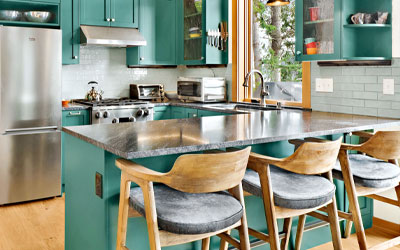The Pacific Northwest Modern architectural movement has evolved continuously since its earliest emergence in the mid-1900s, with 21st century architects adding their own distinctive styles to the mix. The hallmark of today’s PNW Modern architecture lies in how it draws inspiration from the bountiful natural environment and cultural context of the region, while also incorporating newer technology and innovative design solutions. Cabinetry remains an important element of modern interiors, with designers across the region (including here at Smith & Vallee) pushing the boundaries of form and function.
One of the most prominent 21st century architects associated with the PNW Modern movement is Tom Kundig, founder of Olson Kundig. Based in Seattle (and now in New York), Kundig’s designs are known for their bold, industrial aesthetic and innovative use of materials. He often uses raw steel, concrete, and wood to create dramatic interiors that work to blur the line between indoor and outdoor spaces. Kundig’s cabinetry designs are characterized by their clean lines and inventive use of space. He often incorporates sliding panels and hidden compartments into his designs, allowing for seamless transitions between living areas. One of his most famous projects is the Chicken Point Cabin in northern Idaho, which features a stunning retractable wall that opens onto the lake.
Another renowned 21st century architect associated with the PNW Modern movement is Stuart Silk, founding principal of Stuart Silk Architects. Based in Seattle, Silk’s designs are known for their timeless elegance and attention to detail. He tends towards innovative uses of natural materials such as wood, stone, and glass to create interiors that blend seamlessly with the surrounding landscape. Silk’s cabinetry designs are characterized by their minimalist aesthetic and emphasis on craftsmanship. He works closely with artisans, designers, and woodworkers to create custom pieces that complement the overall design of a space. One of his many celebrated projects is the North Shore Residence, which features a breathtaking wine cellar with custom wood shelving and display cases.
A third well-known architect from the area is Eric Cobb, of Cobb Architects. Also based in Seattle, Cobb’s designs are known for their use of sustainable materials and energy-efficient systems. He often incorporates green roofs, rainwater harvesting systems, and passive solar design into his projects. Cobb’s cabinetry work is characterized by its sleek, contemporary aesthetic and focus on functionality. He often uses modular cabinetry systems that can be easily reconfigured to suit a customer’s individual needs. Check out his work on this Market Condo in downtown Seattle, which overlooks Elliot Bay and creates a soothing, calming space right in the heart of the crowded city.
The cabinetry designs of these 21st century architects continue to push boundaries, creating beautiful spaces that incorporate innovative materials inspired by the incredible natural landscape of the Pacific Northwest. The role of cabinetry in modern interiors has evolved, with designers creating custom pieces that are both functional and aesthetically pleasing. Here at Smith & Vallee, we’re honored to work closely with local architects, interior designers, and contractors to help bring our customers’ visions to life! If you’d like to learn more about our offerings and see some examples of our custom cabinetry in gorgeous homes across the northwest, such as this Craftsman house we worked on in 2022, reach out to us at any time. We’d love to hear from you and make your design dreams a reality.
In conclusion, the PNW Modern architectural movement is alive and thriving in the 21st century, with architects continuing to push the boundaries of design and incorporate innovative techniques and materials into their work. Cabinetry remains a crucial component of modern interiors, with designers collaborating with skilled craftspeople to create custom pieces that are both practical and visually stunning. As the PNW Modern movement evolves, we’re so excited to see how architects continue to draw inspiration from the natural beauty and cultural context of the region while embracing new technologies and design solutions.

